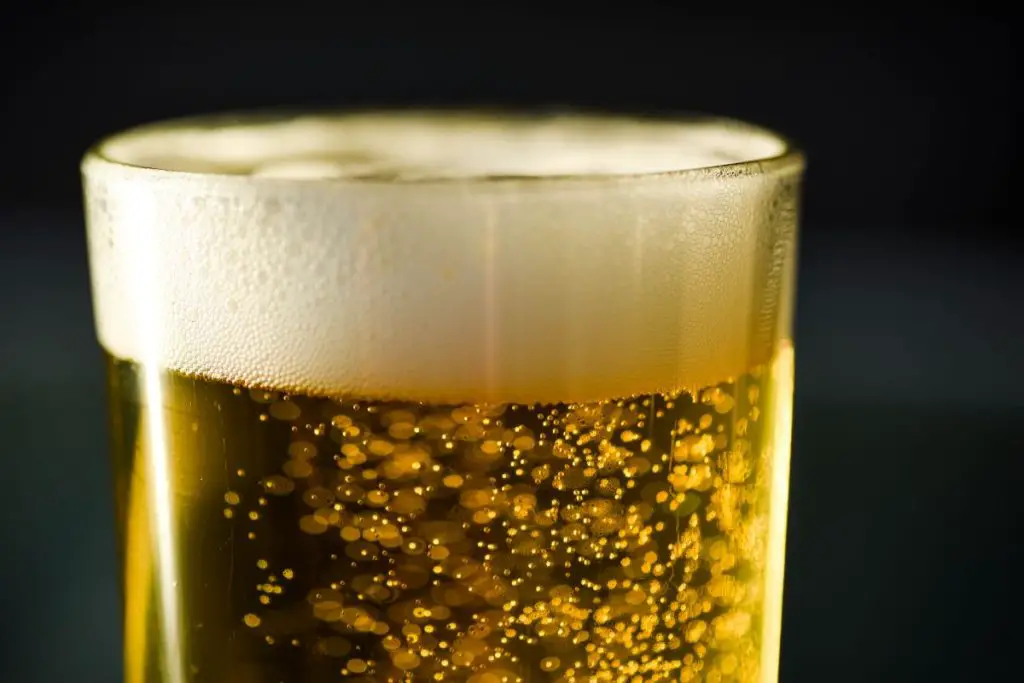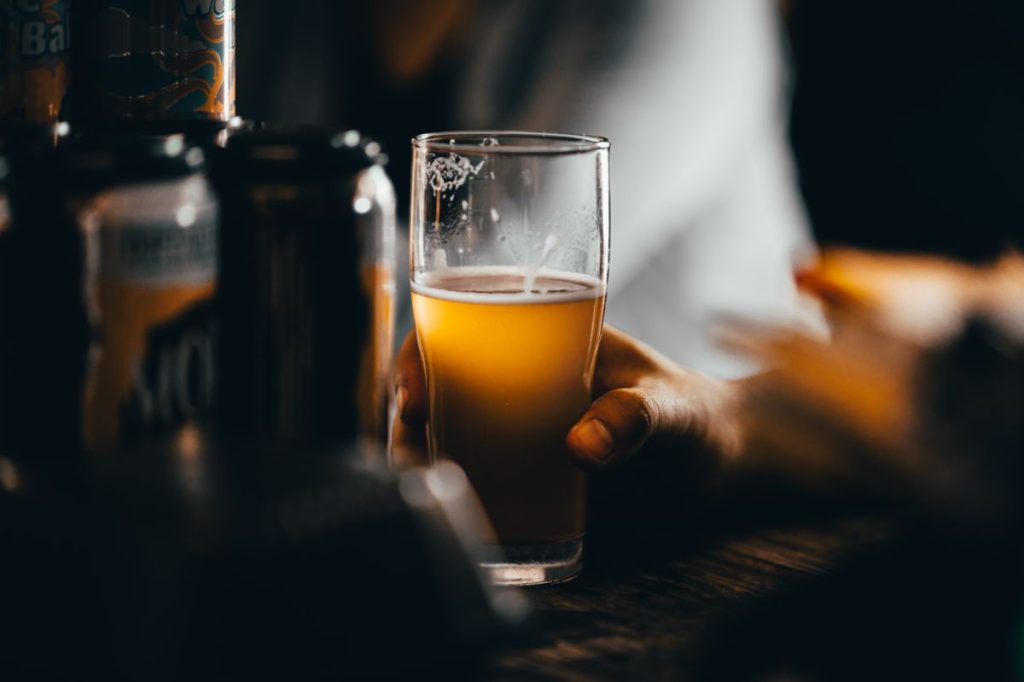Curious about how much alcohol is in beer?
In this post, we’ll explore some of the most popular beer styles and their alcohol content ranges.
Each style is unique, from light and refreshing beers to robust and potent brews.
Discover a spectrum of flavors and strengths as we delve into the captivating world of beer, one ABV at a time.
Let’s get to it!
How Much Alcohol is in Beer?
Domestic beers typically contain between 3% and 14% alcohol by volume (ABV).
However, this range can vary wildly in both directions!
Believe it or not, there are some beers out there with more than 40% alcohol, making them stronger than vodka or rum.
On the other end of the spectrum, you’ll find low-alcohol beers with only 1.2% alcohol.
These are typically marketed toward folks who are watching their waistlines.
Craft beers tend to have higher ABVs, often surpassing 8%.
That makes them pretty strong.
So, if you’re looking for a beer with a little extra kick, craft beers are a great choice.
Learn all about beer alcohol percentages.
Types of Beer by Alcohol Content
Lager (3%-6% ABV)

Lager is a type of beer known for its crisp and clean taste.
It undergoes a cold fermentation process, which contributes to its refreshing character.
Lagers typically have a lighter color, moderate carbonation, and a balanced flavor profile.
Here are some famous examples:
- Augustiner Amber Lager (4.3% ABV)
- Brooklyn Lager (5.2% ABV)
- Flying Dog Old Scratch Amber Lager (5.5% ABV)
- Grolsch Light Lager (3.6% ABV)
- Yeungling Lager (4.5% ABV)
Stout (4%-32% ABV)
Stouts are dark and rich beers known for their robust flavors and creamy textures.
They typically feature roasted malt flavors with hints of chocolate, coffee, and sometimes even caramel.
Stouts are full-bodied and often have a higher alcohol content.
Here are some famous examples:
- Bluegrass Jeffersons Reserve Big Fella Bourbon Barrel Stout (18% ABV)
- Brooklyn Black Chocolate Stout (10% ABV)
- Guinness Extra Stout (5% ABV)
- Sam Adams Imperial Stout (9.2% ABV)
- Sierra Nevada Stout (5.8% ABV)
Here are delicious chocolate stout recipes for you to try!
Pilsner (4%-6% ABV)
Pilsners are crisp and refreshing beers originating from the Czech city of Pilsen.
They are characterized by their pale golden color, clean malt profile, and distinct hop bitterness.
Pilsners have a light sweetness and a dry finish.
Here are some famous examples:
- Brooklyn Pilsner (5.1% ABV)
- Pilsner Urquell (4.4% ABV)
- Pacifico Pilsner (4.5% ABV)
- Stella Artois Belgian Pilsner (4.6% ABV)
- Victory Prima Pilsner (5.3% ABV)
Ale (2%-12%)
Ales is a diverse family of beers known for their complex flavors.
They are fermented with top-fermenting yeast at warmer temperatures.
Ales can exhibit fruity, malty, hoppy, and spicy notes.
Here are some famous examples:
- Bud American Ale (5.3% ABV)
- Deschutes Mirror Pond Ale (5% ABV)
- Dogfish Head Shelter Pale Ale (5% ABV)
- Irish Red Ale (5.7% ABV)
- Winter’s Bourbon Cask Ale (6% ABV)
Try this Nut Brown Ale recipe all grain.
IPA (5%-8% ABV)

India Pale Ales is known for its bold hop-forward flavor profiles.
They often exhibit strong hop bitterness, floral or citrusy aromas, and various hop flavors.
IPAs vary from traditional English styles with balanced bitterness to American versions with intense hop character.
Here are some famous examples:
- Abita Jockamo IPA (6.5% ABV)
- Flying Dog Snake Dog IPA (7.1% ABV)
- Lagunitas IPA (6.2% ABV)
- Omission IPA (6.7% ABV)
- Redhood IPA (6.5% ABV)
Explore the 9 types of IPA and a list of popular brands.
Wheat Beer (2.5%-6% ABV)
Wheat beers are refreshing and light-bodied brews that feature wheat as a key ingredient.
They often exhibit a hazy appearance and a distinct banana or clove aroma.
Wheat beers are known for their smooth and creamy texture.
Here are some famous examples:
- Blue Moon Belgian White (5.4% ABV)
- Allagash Brewing White Wheat Beer (5.2% ABV)
- Sierra Nevada Wheat Beer (4.4% ABV)
- Jack’s Abby Blood Orange Wheat Radler (4% ABV)
- Weihenstephaner Hefe Weissbier (5.4% ABV)
You can go wild by trying this unique taste of banana beer.
Sour Beer (3%-6% ABV)
Sour beers are intriguing brews that offer a tart and acidic flavor profile.
They get their sour characteristic by introducing wild yeast strains or bacteria during fermentation.
Sour beers can range from mildly tart to intensely puckering.
Here are some famous examples:
- Crooked Stave Artisan Beer Project Sour Rosé (4% ABV)
- Two Roads Persian Lime Gose (4.5% ABV)
- Sierra Nevada Wild Little Thing (5.5% ABV)
- Odell Sippin’ Pretty Fruited Sour (4.5% ABV)
- SingleCut Kim Hibiscus Sour (4.2% ABV)
You may also be curious about how to make sour beers.
Porter (4%-12% ABV)
Porters are rich, dark beers with a complex and robust flavor profile.
They are characterized by their deep brown-to-black color, often accompanied by roasted malt, chocolate, and coffee notes.
Porters strike a balance between malty sweetness and roasted bitterness.
Here are some famous examples:
- Anchor Porter (5.6% ABV)
- Michelob Porter (5.9% ABV)
- Sam Adams Honey Porter (5.45% ABV)
- Sierra Nevada Porter (5.6% ABV)
- Yeungling Porter (4.7% ABV)
Let’s delve into a comparison: Porter vs. Ale Brown.
Saison (6%-9% ABV)
Saisons, AKA farmhouse ales, are a style of beer originating from the Belgian countryside.
They are typically light to medium-bodied with a crisp and refreshing character.
Saisons often showcase fruity, spicy flavors and a distinct yeast profile.
These highly carbonated beers can have a dry finish, perfect for warm weather.
Here are some famous examples:
- Brasserie Saison Dupont (6.5% ABV)
- Holy Mountain Witch Finder (6.1% ABV)
- Birds Fly South Rustic Sunday (7% ABV)
- Boulevard Brewing Tank 7 (8.5% ABV)
- Yazzo Brew Saison De Bois (5.8% ABV)
Bock (4%-12% ABV)
Bocks are a type of beer that originated in Germany.
They are typically strong, malty, and full-bodied.
Bocks often exhibit caramel and toasted malt notes, balanced by a subtle hop bitterness.
These beers are known for their smoothness and can range from pale and refreshing to dark and robust.
Here are some famous examples:
- Samuel Adams Chocolate Bock (5.8% ABV)
- Breckenridge Pandora’s Bock (7.5% ABV)
- New Glarus Uff-da (6.7% ABV)
- Michelob Amber Bock (5.1% ABV)
- St. Nikolaus Bock Bier (6% ABV)
Beer by Alcohol Content FAQs
That would be the Scottish beer Brewmeister Snake Venom, which contains 67.5% ABV!
If we’re talking beer styles, Imperial Stouts and Barleywines are typically known for having the highest ABVs.
When you spot the ABV (alcohol by volume) indicated on a beer bottle, you know how much alcohol is in the drink.
You have a 12-ounce beer bottle with a 5% ABV.
That means the entire drink contains about 0.6 ounces of pure alcohol.
It sure can!
Let’s say you’re enjoying a 16-ounce beer with a 5% ABV, weighing around 150 lbs.
In this case, it would take roughly five and a half beers for you to reach the legal intoxication limit.
Everyone’s tolerance can vary, so it’s important to drink responsibly and know your limit!
Conclusion
So, here’s the fascinating truth: the alcohol content of brews varies significantly across different styles.
You have many options, whether looking for an easy-sipping beer or one that packs a boozy punch.
So, raise your glass and savor the flavors, but always drink responsibly.
Always check the ABV and pace yourself accordingly!
Other Related Articles To Read Below:
Discovering the Craft of Bar Harbor Brewing: A Journey Through 6 Flavorful Beers